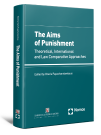A. Sykiotou, Crime policy in a Globalized World, 2022

This work is based on the translation from french of the book published in January 2019 (La politique criminelle sur le fil, Paris: Institut de Recherche Juridique de la Sorbonne–IRJS, coll. Les voies du droit, pp. 458). The present book is an updated version and the bibliography has been enriched with new references. In addition, a post-script has been added in order to highlight some issues of the pandemic.
Reading this book is illuminating well beyond the sphere of criminal law and even beyond the limits of the States. By studying the global challenges, we go from terrorism to the financial crisis, from international human rights law to international trade law, but also from national law to European or even global law. In all these domains, the author observes not only the behaviors of the States, but still the rise of transnational corporations (TNCs). She explores the main crime policy trends, with special emphasis on the concept of public security and on the relationship between human security and market security and considers the role of new technologies in the formulation of crime policy choices.
The ambition of her work is not limited only to portray but it is further accompanied by a critical reflection that leads the reader to address, in the ‘concluding chapter’, the crucial question if these drifts of a democratic and liberal crime policy, toward an authoritarian –even totalitarian– model and sometimes even toward a society of permanent monitoring, are now irreversible or if there are effective remedies.
Πληροφορίες έκδοσης
Πίνακας περιεχομένων +-
Table of contents
Acknowledgments
Forword
Forewοrd to the French Edition
Abbreviations
Introduction
PART ONE
“Fluctuat Nec(dum) Mergitur”. From an ‘Anodyne’ to a ‘Painful’ Crime Policy
Chapter 1: What kind of Law are we talking about?
Section 1: Is there a legal framework for the crime policy of today?
§1: Global Norms and the Law
§2: The interdependence of norms
§3: Redefining Law?
Section 2: The interrelation between globalization, State, democracy and crime policy
§1:
The remodeling deriving from the economic crisis and the rule of Law
§2: The democratic retreat
§3: The redress of the rule of Law
Chapter 2: The ‘anodyne’ crime policy: From self-regulation to restorative justice
SECTION 1: Current crime policy trends and the change in the concept of punishment
§1: The contrary trends in crime policy
§2: Reflections on the concept of punishment
§3: The diptych ‘sanction-reparation’
SECTION 2: Self-regulation: A choice of ‘anodyne’ crime policy, but for whom?
§1: Rules of corporate governance
§2: An imposed self-punishment
§3: The upheaval of the Law
Chapter 3: The ‘civilization’ of criminal law or the end of a dogma?
SECTION 1: ‘Civilization’ or ‘Americanization’ of Criminal Law?
§1: The globalization of the American Law
§2: The managerial logic of danger
§3: The patrimonialization of the repression
SECTION 2: The fuzzy limits of criminal responsibility
§1: The vacuum of criminal responsibility
§2: Neutralization versus fair punishment
§3: From ‘honest people’ to potential terrorists
Chapter 4: The ‘hard to swallow’: The crime policy that hardens its responses
SECTION 1: Crime policy of zero tolerance or crime policy of risks
§1: The common good of public security and the proliferation of risks
§2: The logic of ‘zero tolerance’
§3:
Preventive controls and ‘zero tolerance’ deriving from economic crisis
SECTION 2: ‘Terrorism of proximity’ and criminal psychopaths
§1: A new profile of terrorism
§2: ‘Balanced’ or ‘unbalanced’ terrorists?
§3: The official establishment of the ‘terrorism of proximity’
PART TWO
The extra-national influences on national crime policy: Global or universal crime policy?
Chapter 1: Conflicting influences on national crime policy
SECTION 1: Supranational influences on national crime policy
§1:
The influences of supranational bodies on the legislative power of States
§2: The influence of supranational courts’ case law on national law
§3:
Influences on national law from international non-governmental organizations
SECTION 2: Trans-state influences
§1: Influences from one State to another
§2: Interventions of public agents of a State to another
§3: Influences of private entities within a State
Chapter 2: The economic globalization of the Law
SECTION 1: From security of persons to security of markets
§1: The consequences of the economic liberalism on the Law
§2: The ‘bancocracy’
§3: Economic crises: the Greek example
SECTION 2: The influences of transnational corporations on national crime policy or the dictatorship of the markets
§1:
The means used by transnational corporations to influence the national crime policy
§2:
The criminal activity of transnational corporations and the organized crime
§3:
The non-existence of international responsibility for transnational corporations
Chapter 3: The support of new technologies to crime policy
SECTION 1: Technological evolution, economic challenges and a fragile crime policy
§1: Digital technologies and electronic monitoring
§2: From digital interceptions and biometrics to genetic fingerprints
§3:
Economy and technology in the service of a society of ‘permanent monitoring’: Freedoms restricted but profitable market
SECTION 2: From GMOs to artificial intelligence: The mutation of crime policy?
§1: Positive and negative eugenics is already here…
§2: From Lombroso to neuroscience: No room for the ‘out of standards’
§3: A ‘genetically modified’ crime policy
Chapter 4 (conclusion): Is there an ‘effective remedy’?
SECTION 1: Global or universal crime policy?
§1: A globalized crime policy in a non-existing Law
§2: Fragmented human rights: which universality?
§3: The ‘resistance’ is getting organized
SECTION 2: “Fluctuat aut mergitur ?”
§1: The challenge of a better world
§2: The ultimate remedies or the utopia of healing
§3: The ‘critical mass’
Post-script
Bibliography (main sources)
Thematic index





















